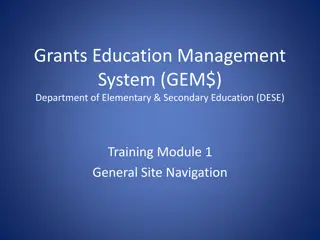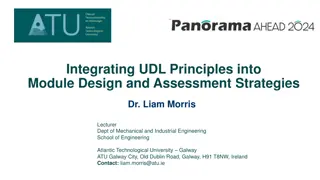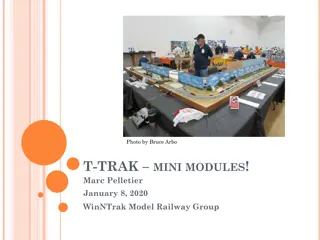Understanding eQTL Analysis in Gene Expression Profiling
This module delves into Expression QTL (eQTL) analysis, which links genotype to phenotype through transcript abundance modulation. The complexity of eQTLs, including cis vs. trans regulation, clustering, and the genetic component of transcription, is explored. Meta-analyses and tools like GTEx provide insights for further research in this field. Various software like PLINK, Matrix eQTL, GEMMA, and FMeQTL facilitate efficient analysis of eQTLs.
Download Presentation

Please find below an Image/Link to download the presentation.
The content on the website is provided AS IS for your information and personal use only. It may not be sold, licensed, or shared on other websites without obtaining consent from the author. Download presentation by click this link. If you encounter any issues during the download, it is possible that the publisher has removed the file from their server.
E N D
Presentation Transcript
Summer Institutes of Statistical Genetics, 2020 Module 6: GENE EXPRESSION PROFILING Greg Gibson and Peng Qiu Georgia Institute of Technology Lecture 9: eQTL ANALYSIS greg.gibson@biology.gatech.edu http://www.cig.gatech.edu
Expression QTL analysis The architecture of transcription maps genotype onto phenotype Expression QTL (eQTL) are QTL that modulate transcript abundance in pedigrees or crosses Expression SNP (eSNP) are SNPs that associate with transcript abundance in cohort studies GWAS variants and eSNP often colocalize, but it is not that simple At least 10% of transcripts differ in abundance between any two strains of most organisms; more than 50% across a species Estimates of heritability of transcription also suggest that transcription often shows a higher genetic component than visible traits One prominent eSNP may have the largest effect, but typically multiple variants at a locus will independently regulate the transcript, and overall trans-effects explain more of the variance
cis cis and and trans trans eQTL eQTL Strong tendency for eQTL to be in cis to the actual gene Occasionally trans-eQTL clustered in hotspots Ever-larger eQTL studies refine resolution and increase number of discoveries Yeast: Ronald and Akey (2007) PLoS ONE2: e678 Mice: Schadt, Friend et al (2003) Nature422: 297-302
Meta-analysis http://genenetwork.nl/bloodeqtlbrowser/ eQTL meta-analysis on 5,311 individuals replicated in 2,775 more Found trans-eQTL for 233 SNPs at 103 loci many of which are also disease QTL Also generates local cis-eSNPs for almost half the genome Westra et al. (2013) Nature Genetics 45: 1238 1243
GTEx (Genotype-Tissue-Expression Project) Science (2015) 9(5): e1003486
Some software PLINK: The basic tool for GWAS http://pngu.mgh.harvard.edu/~purcell/plink/tutorial.shtml Matrix eQTL: Ultra-fast eQTL analysis http://www.bios.unc.edu/research/genomic_software/Matrix_eQTL/ GEMMA: Genome-wide Efficient Mixed Model Association (GEMMA) http://stephenslab.uchicago.edu/software.html#gemma FMeQTL: Bayesian Joint mapping https://github.com/xqwen/fmeqtl DAP: Deterministic Approcimation of Posteriors (Fast Bayesian) https://github.com/xqwen/dap CAVIAR: Bayesian Fine Mapping http://genetics.cs.ucla.edu/caviar/ Ventham et al (2016) Nature Communications 7: 13507
Why Colocalized Signals do not alone imply Causation Sampling variance means that we can only map credible intervals Many genes harbor multiple eSNPs, and possibly multiple trait associated SNPs LD means that multiple sites can interfere with one another in estimation of peak locations The nearest gene is only sometimes the one affected by a SNP!
Coloc: A Bayesian test for colocalization of pairs of association signals H1 is the hypothesis that there is only an eQTL signal at a locus H2 is the hypothesis that there is only a GWAS signal at a locus. H3 is the hypothesis that there are two independent eQTL and GWAS signals in linkage. H4 is the strong hypothesis that the same SNP (not just the locus) is responsible for both the GWAS and eQTL. Giambartolomei et al (2014) PLoS Genetics 10(5): e1004383
Examples of H3 and H4 Examples of H3 and H4 On the left, the profile of association at the FRK locus with LDL (top) is very different from that with FRK expression. H3 is the supported hypothesis. On the right, even though there are two different peak SNPs, they are in the same strong LD region and the profiles are almost the same for Total Cholesterol and Soc1 expression. H4 is the supported hypothesis. Bayesian analysis evaluate each H relative to the other four and generates a confidence level for the most likely one. Giambartolomei et al (2014) PLoS Genetics 10(5): e1004383
SMR and SMR and coloc coloc are complementary are complementary H4-supported
Limitations of colocalization analyses Heavily dependent on statistical power of the contributing analyses, which is generally relatively low Depends on high quality imputation if the SNPs are not directly typed Assumes that the GWAS and eQTL are evaluated on the same population (there is no stratification) A negative result may arise if the incorrect tissue is being studied for the gene expression Assumes there is a single causal variant at each locus for each effect (which is very unlikely) although this example shows that conditional analysis has the potential to resolve joint effects Giambartolomei et al (2014) PLoS Genetics 10(5): e1004383
Joint Mapping Joint Mapping A variety of open source methods are appearing that utilize Bayesian methods to perform joint mapping of eQTL A statistical framework for joint eQTL analysis in multiple tissues. Flutre T, Wen X, Pritchard J, Stephens M. PLoS Genet. 2013 9(5): e1003486. This paper shows that combining signals across tissues increases power while also allowing assessment of whether the effect sizes are different in different cell types. Implemented in eQTLBMA software. Cross-population joint analysis of eQTLs: Fine mapping and functional annotation. Wen X, Luca F, Pique-Regi R. PLoS Genet. 11(4): e1005176. This paper shows that combining signals across populations increases power while also allowing assessment of how incorporating ENCODE data improves resolution. Implemented in FM QTL software. Efficient integrative multi-SNP association analysis via Deterministic Approximation of Posteriors Wen X, Lee Y, Luca F, Pique-Regi R. AM J Hum. Genet. 98(6): 1114-1129. This paper extends the framework for incorporating ENCODE data while allowing for multiple causal variants at each locus. Implemented in DAP software: http://github.com/xqwen/dap/
eQTL and Additivity Pickrell et al. (2010) Nature 464: 768-772
WASP Formulates a CHT: Combined Haplotype Test The CHT jointly models two components: the allelic imbalance at phased heterozygous SNPs and the total read depth in the target region https://github.com/bmvdgeijn/WASP Van de Geijn, et al (2015) Nature Methods 12: 1061-1063
sQTL (Splicing QTL) Pickrell et al. (2010) Nature 464: 768-772
MISO: Mixture of Isoforms http://genes.mit.edu/burgelab/miso/ Estimates the Percent Spliced In (PSI, ) for various features: Alternate First Exon Mutually exclusive Exon Excluded Exon Included Intron Alternate Splice Donor Alternate Splice Acceptor Alternate 3 end Katz et al. (2010) Nature Methods 7: 109 115
Transcriptional Risk Scores - theory Gibson et al (2015) Genome Medicine 7: 60
Transcriptional Risk Scores for Crohns Disease Healthy-Disease Disease Progression























